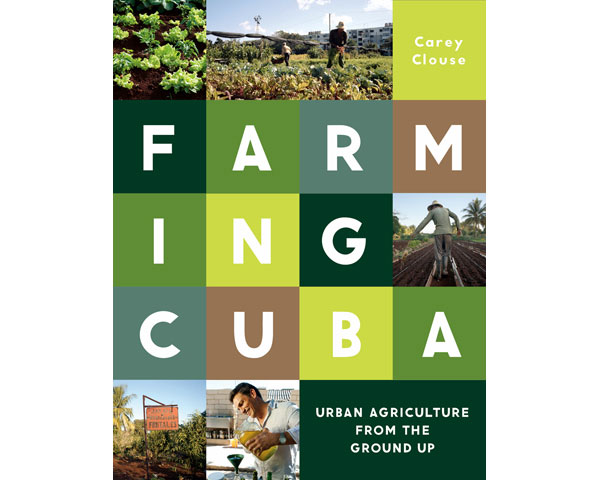
Author: Carey Clouse (Princeton Architectural Press, 2014)
In light of growing urban populations and diminishing resources, the issues around food security and the importance of urban agriculture have been growing steadily over the years. Within this context, the humble Republic of Cuba sits firmly as a significant exemplar of how to cultivate, process, and distribute food in the urban settling. Carey Clouse’s Farming Cuba: Urban Agriculture from the Ground Up is the most recent books describing Cuba’s contributions to the issue, with an intriguing architectural spin to the subject.
This tightly packaged book (approx. 200 pages from cover to cover) is divided into 5 main chapters – Urban Farming in Cuba, Networks and Garden Typologies, Support, Designing and Planning, and Moving Forward – each of which is separated by essays written by outside contributors. These chapters are bookended by succinct, well-written Introduction and (one-page) Afterword. The content is accompanied by a number of excellent drawings and photographs.
The first chapter, Urban Farming in Cuba, gives the reader a concise history of urban farming in Cuba – from the First Agrarian Reform Law in 1959 through the effects of collapse of the Soviet Bloc in 1989 to the recent past. It offers a good foundation for those how do not understand the birth of the urban agriculture movement in the country.
The is followed by what any urban designer or architect would deem the most valuable (and unique) chapter – Networks and Garden Typologies – that verbally and graphically describes different scales of urban farms in Cuba. From the Micro-gardens of less than 100 sq. meters to 10,000-20,000 sq.m. Organic Matter Production Centers, this section gives readers a terse, but amazingly informative typological study of farm types.
The written description of the farm types include the spanish name, english name, date started, number of farm types in the country (if available), products cultivated, purpose, spatial/architectural elements, number of farmers that work their, and additional details (i.e. how they function, etc.). If this isn’t valuable enough, this great information is supplemented by paraline drawings that spatialize all the main architectural elements of the farm types, as well as a handful of photographs.
The only downside to this chapter is a layout flaw: unfortunately, the descriptions of the farm types and images are not adjacent, so readers will constantly find themselves frustratingly flipping back and for the between the drawings/photos and written content.
Regardless, the value of this section cannot be understated for designers, as one rarely encounters books that look at urban agriculture typologically, let alone spatialize their architectural composition. Needless to say, it is a very information-rich section and well worth picking up the book for this reason alone.
The remaining three chapters round out the content, focusing on the various organizations, programs, and resources that support urban agricultural practices in Cuba (Support), the nature of planning and design (or lack thereof) in the current system (Designing and Planning) and some lessons of note for other countries seeking to improve food security (Moving Forward).
The essays separating chapters vary in quality, some being more interesting and meaningful than others. And although they definitely do not detract from the main content, one may be hard pressed to say that they contributed a lot to Clouse’s work.
Overall, I would highly recommend Farming Cuba: Urban Agriculture from the Ground Up to design students and professionals looking to understand the amazing urban agriculture experiment happening in Cuba and glean some interesting typological insights. Although the chapter on the architectural aspects of the farm types may not be as relevant to the casual reader, the book offers a good foundation and concise introduction great Cuban experiment. One hopes that the great effort and method Clouse put forth will be elaborated upon in the future.
***
For more information on Farming Cuba: Urban Agriculture from the Ground Up visit the PAP website.
**
Erick Villagomez is one of the founding editors at Spacing Vancouver. He is also an educator, independent researcher and designer with personal and professional interests in the urban landscapes. His private practice – Metis Design|Build – is an innovative practice dedicated to a collaborative and ecologically responsible approach to the design and construction of places. You can see more of his artwork on his Visual Thoughts Tumblr.


